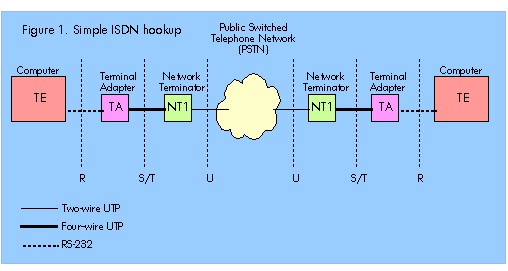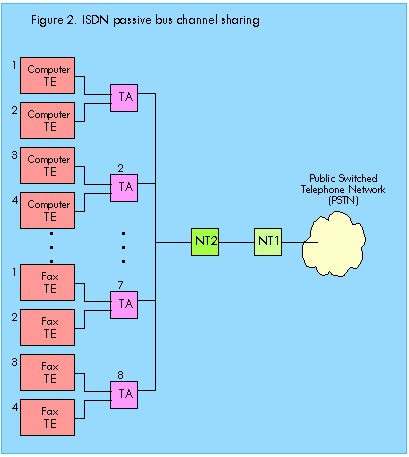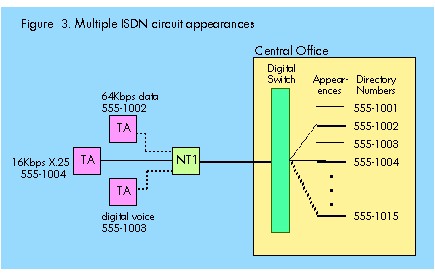|
|


Interactive Voice Response
This section of our technical library presents information and documentation relating to IVR and interactive voice response software as well as automatic call answering solutions.
Business phone systems and toll free answering systems (generally 800 numbers and their equivalent) are very popular for service and sales organizations, allowing customers and prospects to call your organization anywhere in the country.
Our PACER and Wizard IVR systems add another dimension to our call center phone system solutions. An Interactive Voice Response (IVR) processes inbound phone calls, plays recorded messages including information extracted from databases and the internet, and potentially routes calls to either in-house service agents or transfers the caller to an outside extension.
An Introduction to ISDN
by Mel Beckman
HowStuffWorks.com
Why ISDN?
If you've used some of the newer Internet facilities -- such as graphical World Wide Web browsers or CU- SeeMe video conferencing -- over a modem connection, you realize that accessing the Internet at current modem data rates provides barely adequate performance. As applications become more sophisticated and require more bandwidth, this situation will only worsen. And if you're putting an entire corporate LAN on the Internet, a modem connection becomes a serious bottleneck. Unfortunately, the current crop of high-speed modems, running at 28.8 Kbps, are about as fast as modems will ever get. That's because a physical speed barrier exists at 30 Kbps -- a barrier that can't be broken without abandoning the modem's analog signaling for something completely different (see see The Truth About High-Speed Modems).
That "completely different" something is digital signaling, in the form of Integrated Services Digital Network (ISDN). Using the same copper phone lines that modems use, ISDN delivers a five-fold speed improvement (up to 128 Kbps) and provides essentially perfect transmission reliability. And ISDN can mesh into other digital technologies, such as Frame Relay and ATM, making possible future speeds several times higher even than 128 Kbps.
The "Integrated" part of ISDN's name refers to the combining of voice and data services over the same wires (so computers can connect directly to the telephone network without first converting their signals to an analog audio signal, as modems do). This integration brings with it a host of new capabilities combining voice, data, fax, and sophisticated switching. And because ISDN uses the existing local telephone wiring, it's equally available to home and business customers. Most important for Internet users, however, is that ISDN provides a huge improvement in access speed at only a fractional increase in cost.
ISDN service is available today in most major metropolitan areas and probably will be completely deployed throughout the U.S. by the end of 1995. Many Internet Service Providers (ISPs) now sell ISDN access -- some for little more than you'd currently pay for modem access (about $1/hr). To find out if ISDN will work for you, you need to understand the capabilities ISDN offers, how it delivers them, and what it all costs in equipment and fees.
The Basics
ISDN provides a raw data rate of 144 Kbps on a single telephone company (called telco in the business) twisted pair. To better suit voice applications, this 144 Kbps channel is partitioned into subchannels: two 64 Kbps B (for bearer) channels and one 16 Kbps D (for data) channel. Each B channel can carry a separate telephone call and usually has its own telephone number, called a Directory Number (DN). You can combine the two B channels together to form a single 128 Kbps data channel through a process called bonding (more on that later).
Figure 1 shows a minimal ISDN setup connecting two computers. The incoming twisted pair enters a telco-provided box called the network terminator (NT1), which breaks the 144 Kbps channel into the two B and single D subchannels. (If you're wondering how ISDN squeezes 144 Kbps out of the same twisted pair that modems struggle with at 28.8 Kbps, read see How ISDN Does It).

The B channels carry customer voice or data signals. The D channel carries signals between your ISDN equipment and the phone company's central office. The two bearer plus one data channel is called the Basic Rate Interface (BRI) in telco lingo, or sometimes just 2B+D for short. You also can buy ISDN in bulk: 23 B channels with a single 64 Kbps D channel. This service, called the Primary Rate Interface (PRI), inherits most of the capabilities and limitations of BRI, so what you learn about 2B+D applies to PRI's 23B+D service, as well.
Continuing with Figure 1, a single four-wire cable carries the 2B+D channels to another box called the Terminal Adapter (TA). Unlike the NT1, which provides only a single function (creating the 2B+D channels), the TA can do many things. Its job is to connect any and all of your Terminal Equipment (TE) -- computers, fax machines, LANs, or telephone sets -- to one or both of the B channels. Depending on the variety of terminal equipment you want to connect, the TA might be cheap or expensive, simple or complex. In this example, the TA is shown as a separate unit, but it could easily be contained within the computer (as an add-in card or integrated feature) or integrated with the NT1 into a single box as a modem replacement or stand-alone TCP/IP router. ISDN's current popularity is stimulating the introduction of new TAs regularly.
Figure 1 also shows the external ISDN reference points, labeled R, S/T, and U. (Don't strain yourself trying to deduce what R, S, T, and U stand for -- they are simply consecutive letters of the alphabet, chosen by the ITU -- The International Telegraphic Union, a standards-setting body -- as the next available designations from the entire set of ITU standards.) Each interface point requires an electrically different device connection and cabling. The U reference point is the incoming unshielded twisted pair (UTP); the S/T reference point is a four-wire UTP cable.
A typical TA for data-only applications might simply emulate a pair of ordinary (albeit very fast) Hayes-compatible modems, translating standard modem setup and dialing commands into ISDN call-setup commands. You connect your computer to this kind of TA with a normal RS-232 cable and use your usual modem or fax software set to 64 Kbps (or as high as you can go). The TA provides automatic rate adaptation to match whatever data rate your computer supports with ISDN's 64 Kbps channel, so that if your computer can't communicate faster than, say, 38.4 Kbps, it will still work fine under ISDN (and even connect properly to a remote computer operating at some other speed). An example of a more sophisticated TA is the ISDN router, which connects to an ISDN line on one side and your office or home LAN on the other. An ISDN router can carry your network traffic -- AppleTalk, IPX, TCP/IP -- either down the street to your main office or around the world on the Internet. The advantage of an ISDN router over the simpler modem-replacement TA is the ability to support many different kinds of computers without special ISDN software; the router contains all the intelligence necessary to move traffic over an ISDN link, literally moving your local LAN to the far-away destination of your choice.
"But wait!" you cry. "All you've done so far is replace modems with a lot of extra boxes and wires. If this is all ISDN offers, what good is it?" Remember, the example in Figure 1 is a minimal ISDN setup. Even with this bare-bones configuration, though, you're getting the equivalent of two 64 Kbps modems, two telephone lines, and virtually guaranteed reliable data transport. This last item is an important advantage over analog modems, which suffer from all kinds of maladies ranging from intermittent line noise to speed mismatches and protocol conflicts.
Because ISDN is purely digital, the telco can more easily deliver data intact from end to end, largely eliminating the effects of noise. And because the 64 Kbps channel is essentially a pure "bit pipe," with no rate negotiation or handshaking involved, there are no modem speed or protocol differences to cause conflicts. In fact, because the negotiation phase with ISDN is so simple, ISDN takes only a second or two to dial and establish a connection (modems may take as long as a minute to accomplish the same thing). These benefits alone are worth the cost of two high-speed modems, which is about what a bare-bones TA costs.
In an Internet-access application, your computer treats the basic TA just as it would a modem, using the PPP (Point-to-Point) serial line protocol to carry your Internet traffic. From your point of view, then, the ISDN connection setup is identical to the setup a PPP modem Internet connection. Although you could technically run the popular SLIP (Serial Line Internet Protocol) over ISDN, PPP is the ISDN transport protocol of choice for several reasons. First, PPP is built into a number of ISDN-capable routers on the market, and your ISP will likely be using one of these routers to provide ISDN dialup service. Second, a variant of PPP, called MPP (for Multichannel Point-to-Point Protocol) lets you combine the two 64 Kbps D channels to create one 128 Kbps bonded channel. This is also called inverse multiplexing, and is usually set up to provide bandwidth on demand -- only adding the second channel when network traffic warrants. Bandwidth-on-demand is a cost-saving feature. Each D-channel ISDN connection is treated as a separate phone call, so having two channels up costs twice as much as one if your ISDN connection has per-minute usage fees associated with it. For flat-rate ISDN calls, you can permanently bond the D channels.
Getting Clever
Beyond a basic ISDN setup, you can set up ISDN to simulate the features of an office PBX, using advanced TAs or direct computer-integrated ISDN hardware. If you're using an ISDN connection for telecommuting or branch offices, for instance, you may want to take advantage of ISDN voice features. ISDN offers a number of flexible options for mixing voice and data traffic. For example, although a 2B+D interface provides only two bearer channels, you're only limited to two devices using those channels at any one time. Up to eight devices can share access to the channels using a feature of ISDN called passive bus. Passive bus uses a second kind of network terminator, called an NT2, to let up to eight separate TAs share a single 2B+D circuit. TAs that support passive bus have a port labeled S/T, to indicate that you're making the connection at the S/T ISDN reference point.

Figure 2 shows a passive bus with a dozen computers and four fax machines sharing an ISDN circuit. You need one TA for every two pieces of terminal equipment. Whenever a computer or fax machine wants to use a B channel, its associated TA checks to see if a channel is available, and, if so, dedicates it to the requesting TE. The example shows maximum device sharing, but the cost of additional 2B+D circuits is low enough that you'll likely have fewer devices on a single bus.
An alternative to using an external TA is to connect your computer to ISDN directly. You can get adapters for PC, Mac, and RISC systems providing direct ISDN connectivity, and some systems, such as the Sun Sparcstation, have integrated ISDN built in. Along with the adapter, you need software supporting ISDN's call control protocols. Most integrated ISDN products include basic software providing the equivalent of "dumb" TA functionality. You can add options for fax, image, and even video conferencing features. In isolation, these capabilities may not seem useful, but combined with another ISDN feature -- call appearances -- they let you construct sophisticated integrated voice/data applications.
Now Appearing
You're already familiar with the call appearance concept, although you may not know it. The traditional Plain Old Telephone Service (POTS) call waiting and three-way calling features, which let you put a call "on hold" while taking or making a second call, provide two call appearances -- the call you're talking on and the call on hold. ISDN expands that capability to up to 15 separate calls (Figure 3).

For incoming ISDN calls, the telco's Central Office (CO) sends a call setup message to the TA via the D channel, indicating that a call is available to be picked up (if multiple TAs are connected via passive bus, any TA can pick up the call). The TA can answer the call and assign it to an available B channel, or, if both B channels are in use, it can free a channel by placing an active call on hold and making the new call active. These calls can be either data or voice, in any combination. Thus, a single TA could have as many as 15 simultaneous calls in progress, with any two of those calls active (i.e., actually communicating).
If the TA is a personal computer, it can act as a sort of mini-PBX, making possible all sorts of sophisticated call-handling applications. You can transfer calls from one B channel to another (or among 23 B channels on ISDN PRI service), join two or more calls together in a conference, hold active calls, resume held calls, retrieve calling-number identification data, even forward calls to a completely unrelated telephone number (which might not be an ISDN circuit). In practice, multiple call appearances are more useful for voice than data calls, and most data-capable ISDN TAs only support multiple appearances if they also support voice features. Still, the call appearance concept is important in bandwidth-on-demand applications, where one TA might combine both B channels to obtain a 128 Kbps data pipe but relinquish one B channel to answer an incoming call from another location.
All Dressed Up. But Now, Who to Call?
So who will you call with your brand new ISDN connectivity? The obvious first answer is your Internet Service Provider (ISP). Many ISPs are recognizing the performance and reliability improvements of ISDN over modems and are rolling out ISDN services. You can also call other ISDN users, which could be remote sites in your own IS organization, public BBSs, customer sites for EDI or transaction processing, or commercial online services such as CompuServe.
The data applications of ISDN shown so far all require that both parties in the connection have ISDN or packet data service. What if you need to connect with somebody that isn't ISDN capable? The answer is that you use your good ol' analog modem (you didn't throw away your modems yet, did you?) and a TA that supports analog voice connections, or POTS (Figure 4).

This kind of TA accepts an ordinary voice or modem audio signal through a standard RJ11 modular jack and digitizes it for transport across the ISDN interface. It interprets the touch-tone dialing signals put out by your telephone set or modem and generates the required ISDN call-setup signals. If the number you're calling isn't an ISDN POP, the telco equipment at the remote end automatically translates the digitized audio back to analog audio, where the destination modem (or human being) hears what it's always heard before ISDN came along.
This might seem like a terribly roundabout way of maintaining backwards compatibility. It is. But even if ISDN achieves its goal of 95% deployment by the end of 1995, there still will be hundreds of thousands of U.S. modem/fax users, not to mention overseas modems and fax machines. In fact, some ISDN TAs include built-in analog modems (sometimes anomalously called "digital modems") just to provide compatibility with existing analog fax and data devices. So plan on keeping your modems around at least until the end of the decade; you'll still need them occasionally. Fortunately, many TAs provide POTS ports without much additional cost, so this is a painless necessity.
Paying the Data Piper
So what does ISDN cost? That depends on your local telephone company, equipment budget, and ISP. An Internet ISDN connection consists of three componenents: the ISDN line itself, the equipment (an ISDN TA and possibly an NT1), and the ISP's fees.
Many telcos are pricing ISDN similarly to a normal business telephone line, with measured service charges for the time you're actually using the circuit (plus normal long-distance charges when they apply). The cheapest service (PacBell's) runs $30 per month for local access plus message-unit charges of four cents for the first minute and one cent for each additional minute. If the call is long distance, you'll also pay long-distance digital charges, which can be two to three times higher than voice long-distance calls (although competition is rapidly bringing these costs down). Even the most expensive ISDN providers have monthly rates below $100, and many have options that eliminate message-unit charges. For example, PacBell's "Home ISDN" package charges message units only between 8am and 5pm on non-holiday weekdays.
The NT1 costs between $100 and $200, but often you can find TAs with the NT1 device built in. ISDN TAs range in price from as little as $300 for data-only units providing Hayes-compatible modem emulation to $1,500 or more for ISDN-capable routers that can interconnect LANs over ISDN. Standalone TAs often cost less than bus-specific plug-in cards and are usable across a wider range of computer systems. And ISDN routers, which don't depend on your host computer's serial port capabilities, are even more flexable than stand-alone TAs. Unless you have a tightly-coupled ISDN application that requires a plug-in card, you're better off with standalone devices. And unless you're certain you'll never need to connect more than a single computer to the Internet, an ISDN router is a better investment than a serial-port TA that requires host-specific software to operate.
The Right Choice
There seems little doubt that ISDN is in the Internet's future an an entry level connection path. While some critics complain about ISDN's limitations and push alternative solutions (see The Last Mile), the fact is that ISDN is here, and the others aren't. Now that you understand how ISDN works and what it's good for, you can look into using it as an Internet connection alternative. Keep an eye on ISDN technology; prices are coming down and capabilities are expanding.
Wizard Simplifies Development
DSC provides IVR software including our IVR wizard development tool for creating interactive voice response applications.
Our IVR software lets you increase IVR development productivity by providing a visual development environment. IVR applications can be defined in minutes using this sophisticated, yet easy to use development tool.
DSC also has available a comprehensive IVR software library known as our IVR Wizard Software Development Kit. This optional package is available for programmers and systems adminstrators who wish to manage IVR programs fromLinux IVR, Unix, or Windows IVR operating environments.
Data collected by your phone ACD (Automatic Call Distribution) or IVR (Interactive Voice Response) systems can be passed to your existing PC, Unix or Web applications through our phone software.
The PACER predictive dialer can automatically call your customers and pass only connected calls to your agents. With our computer telephony software, your telephone and computer work together to provide cost-saving benefits.
|







